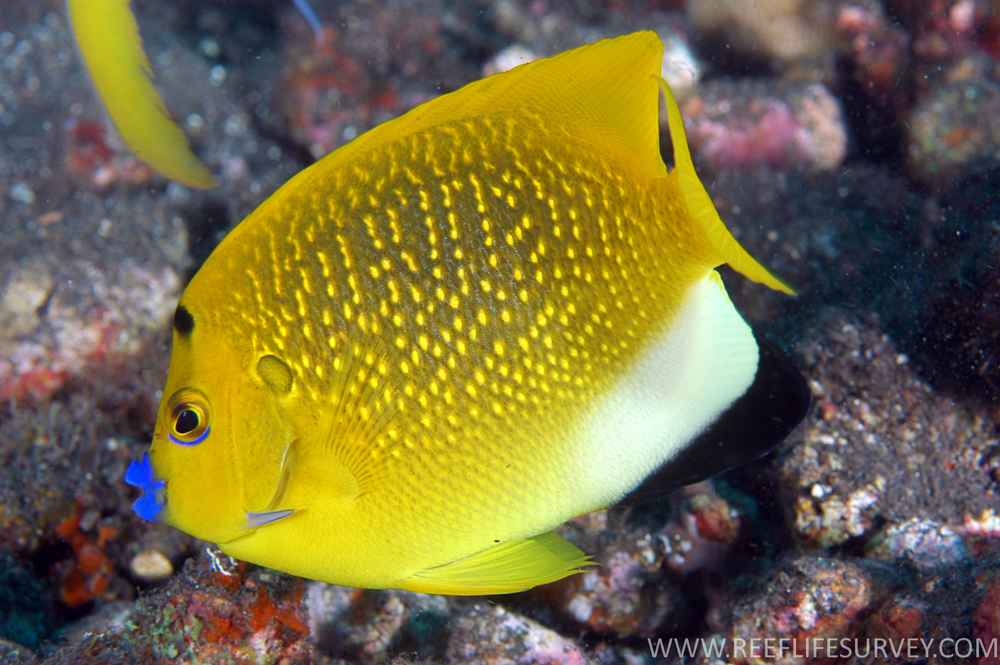- Classification
- ACTINOPTERYGII
- PERCIFORMES
- POMACANTHIDAE
- Apolemichthys
- trimaculatus
Threespot Angelfish, Apolemichthys trimaculatus (Cuvier 1831)
Other Names: Three-spot Angelfish

A Threespot Angelfish, Apolemichthys trimaculatus, at Tulamben, Bali, Indonesia. Source: Ian V. Shaw / Reef Life Survey. License: CC by Attribution
Summary:
A bright yellow angelfish with blue lips, a broad black margin on the anal fin, a black spot on the forehead and an indistinct spot just behind the gill cover. Juveniles lack the spots and have a narrow black band through the eye and golden bars on the side.
Cite this page as:
Dianne J. Bray, Apolemichthys trimaculatus in Fishes of Australia, accessed 20 Apr 2024, https://fishesofaustralia.net.au/home/species/637
Threespot Angelfish, Apolemichthys trimaculatus (Cuvier 1831)
More Info
|
Distribution |
Recorded in Australia from Ningaloo Reef, Rowley Shoals and Scott Reef, Western Australia, Ashmore Reef, Timor Sea, and Escape Reef to Channel Reef , Queensland. Elsewhere, widely distributed throughout the Indian Ocean and the tropical western Pacific Ocean. Solitary or seen in pairs and small groups on outer reef slopes and steep drop-offs, although they also occur found in lagoons and on shallower reefs. Juveniles are secretive and shelter in crevices, usually in depths below 25 m. |
|
Size |
25 cm |
|
Feeding |
Feeds on sponges and tunicates. |
|
Species Citation |
Holacanthus trimaculatus Cuvier 1831, Histoire Naturelle des Poissons 7: 196. Type locality: Moluccas |
|
Author |
Dianne J. Bray |
Threespot Angelfish, Apolemichthys trimaculatus (Cuvier 1831)
References
Allen, G.R., 1985. Butterfly and angelfishes of the world. Vol. 2. 3rd edit. in English. Mergus Publishers, Melle, Germany.
Allen, G.R., Steene, R. & Allen, M. 1998. A Guide to Angelfishes & Butterflyfishes. Cairns : Odyssey Publishing/Tropical Reef Research 250 pp. figs.
Allen, G.R. & M.V. Erdmann. 2012. Reef fishes of the East Indies. Perth, Australia: University of Hawai'i Press, Volumes I-III. Tropical Reef Research.
Allen, G.R., Steene, R.C. & Orchard, M. 2007. Fishes of Christmas Island. Christmas Island : Christmas Island Natural History Association 2 edn, 284 pp.
Allen, G.R. & Smith-Vaniz, W.F. 1994. Fishes of Cocos (Keeling) Islands. Atoll Research Bulletin 412: 1-21.
Cuvier, G.L. in Cuvier, G.L. & Valenciennes, A. 1831. Histoire Naturelle des Poissons. Paris : Levrault Vol. 7 531 pp. pls 170-208.
Endoh, K. 2007. Angelfishes of the World. Two Little Fishies, Inc., Miami Gardens, Florida.
Hutchins, J.B. 2001. Biodiversity of shallow reef fish assemblages in Western Australia using a rapid censusing technique. Records of the Western Australian Museum 20: 247-270.
Kuiter, R.H. 1992. Tropical reef-fishes of the western Pacific Indonesia and adjacent waters. Gramedia Pustaka Utama, Jakarta. 314 p.
Kuiter, R.H., Debelius, H. & Tanaka, H. 2003. Pomacanthidae, a Comprehensive Guide to Angelfishes. Melbourne : Zoonetics 206 pp.
Pyle, R. 2001. Chaetodontidae, Pomacanthidae. pp. 3224-3286 in Carpenter, K.E. & Niem, V.H. (eds). The Living Marine Resources of the Western Central Pacific. FAO Species Identification Guide for Fisheries Purposes. Rome : FAO Vol. 5 2791-3379 pp.
Pyle, R., Myers, R., Rocha, L.A. & Craig, M.T. 2010. Apolemichthys trimaculatus. In: IUCN 2013. IUCN Red List of Threatened Species. Version 2013.1.
Pyle, R.L. & Randall, J.E. 1994. A review of hybridization in marine angelfishes. Environmental Biology of Fishes 41: 127-145.
Randall, J.E., Allen, G.R. & Steene, R. 1997. Fishes of the Great Barrier Reef and Coral Sea. Bathurst : Crawford House Press 557 pp. figs.
Sainsbury, K.J., Kailola, P.J. & Leyland, G.G. 1985. Continental Shelf Fishes of Northern and North-Western Australia. Canberra : Fisheries Information Service 375 pp. figs & pls.
Steene, R.C. 1978. Butterfly and Angelfishes of the World. Australia. Sydney : A.H. & A.W. Reed Vol. 1 144 pp. 216 figs.











